“Antinori makes the point that, even without Sangiovese, Solaia is very “Toscana” – alluding to the minerality of the soil on the estate that is different in composition and produces a very different wine from Bordeaux and even Bolgheri,” writes Dean.
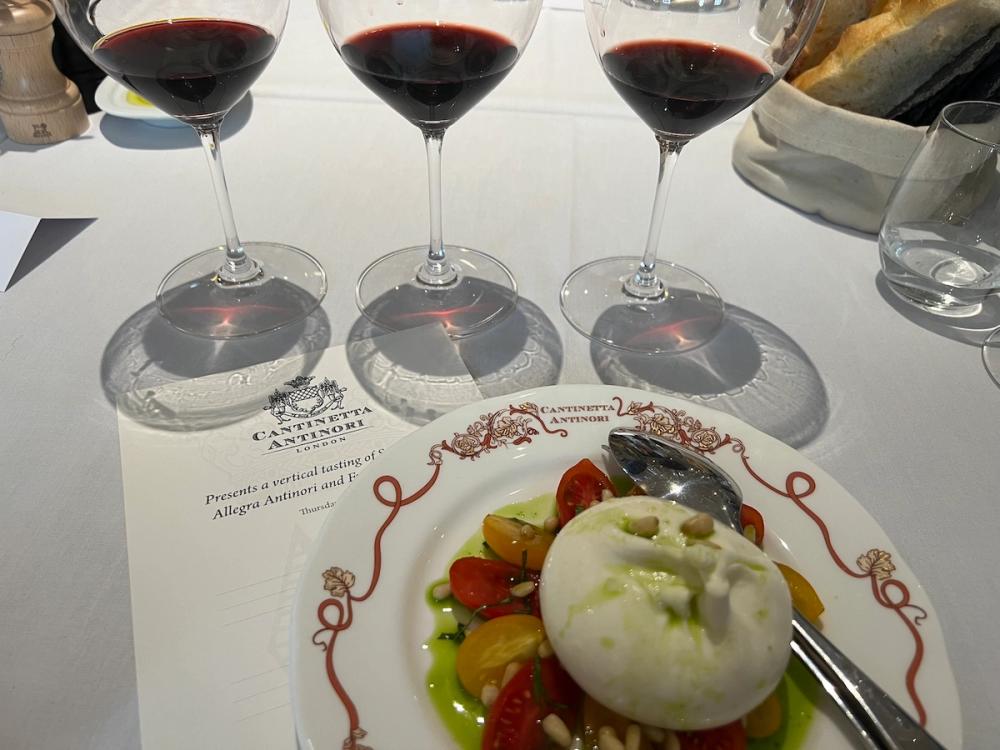
Three vintages of Solaia with one of the starters, June 22, 2023
You know you’re with Tuscan royalty when your host refers to one of the family estates and says with a slight hint of regret that this property is the only one in their portfolio which has a mediaeval castle. But then the Antinoris are no regular hosts. Like a small number of other Italian winemaking dynasties their viticultural history dates back to 1385 when wine tasting notes were presumably recorded on tapestry. The history of the family, its many estates, properties and 26-generation family tree are so rich it would take many a Master of Wine’s thesis to do it justice.
“630 years of history helps you to be patient,” Allegra Antinori explains, when discussing decision-making around the family’s premium wines, “every year we try and do it better, but you have to have some patience not to make wines in some years, but we still work every year to make the wines better.”
“And we have learned from the Bordelais that the next vintage is always the best,” interjects Francesco Visani, Antonori’s export manager, who has Solaia and Tignanello uppermost in his brief.
The debt to Bordeaux is very much part of the core of these two wines, for it is from here that the original Cabernet clones came to make the two wines both from the Tenuta Tignanello estate in Tuscany – Tignanello, one of the first two Super Tuscans and Solaia, a Cabernet-dominant super-premium blend that comes from a 10 hectare vineyard on the same hill as Tignanello and came about, in a moment of inspiration, when the estate had too much Cabernet Sauvignon from the 1978 vintage.
“It was a mix of luck and intuition,” Antinori smiles.
How Solaia is changing year by year

“We don’t want to have wines that are too fat, too powerful,” Solaia export manager Francesco Visani
We are gathered in new eaterie Cantinetta Antinori (going through a soft opening in Knightsbridge) to taste through four vintages of Solaia – the latest, 2019 which was released in April, and three library wines from 2016, 2010 and 2006.
Although Allegra Antinori currently has a particular focus on the hospitality side of the business, by being one of Piero Antinori’s three daughters means she is at liberty to discuss all manner of events: the recent acquisition of Stag’s Leap Wine Cellars (“a bit of craziness”) which the family has taken sole ownership of after having a minor shareholding in the iconic Napa winery for 13 years (and where her father can currently be found); selling Solaia on La Place – the only wine of theirs from its 12 key estates to do so; her grandfather’s purchase of Castello della Sala (yes the one with the medieval castle) in Umbria to make what are now two of Italy’s iconic white wines – Cervaro and Muffatto – both served at lunch.
But the main purpose of proceedings, apart from celebrating the launch of Cantinetta opening in London, is to take a closer look at Solaia – a wine that started as a 80/20% Cabernet Sauvignon/ Franc blend and then included Sangiovese which it has done ever since in varying quantities. The varietal split is usually 75% on average, then 20% Sangiovese and 5% Cabernet Franc, although with the 2016 vintage Antinori has started dialling up the Cabernet Franc and dialling down the Sangiovese, to maintain freshness in the wine in the light of global warming.
Visani confides that he believes the Tuscans are still benefitting short term from the effects of global warming – only one in five vintages are extremely challenging where there used to two or three vintages out of every five. Increasing the amount of Cab Franc in the blend is not the only way they are anticipating further change – replanting newly-acquired vineyards are now done on terraces, and vines are planted with a greatly reduced density with a re-aligned aspect that ‘looks away from the sun’ rather than looks towards it, as the original vineyard at Tenuta Tignanello was planted, hence its name – Solaia, which translates as ‘place of the sun’.
“We are replanting with less vines,” Antinori explains, “the way we planted 30-40 years ago doesn’t work with the weather today. This is where the innovation comes in, we are also looking at a different direction of replating. 30 years ago we planted to catch as much sun as possible – but now we protect the grapes as much as possible, and for that you need more space.”
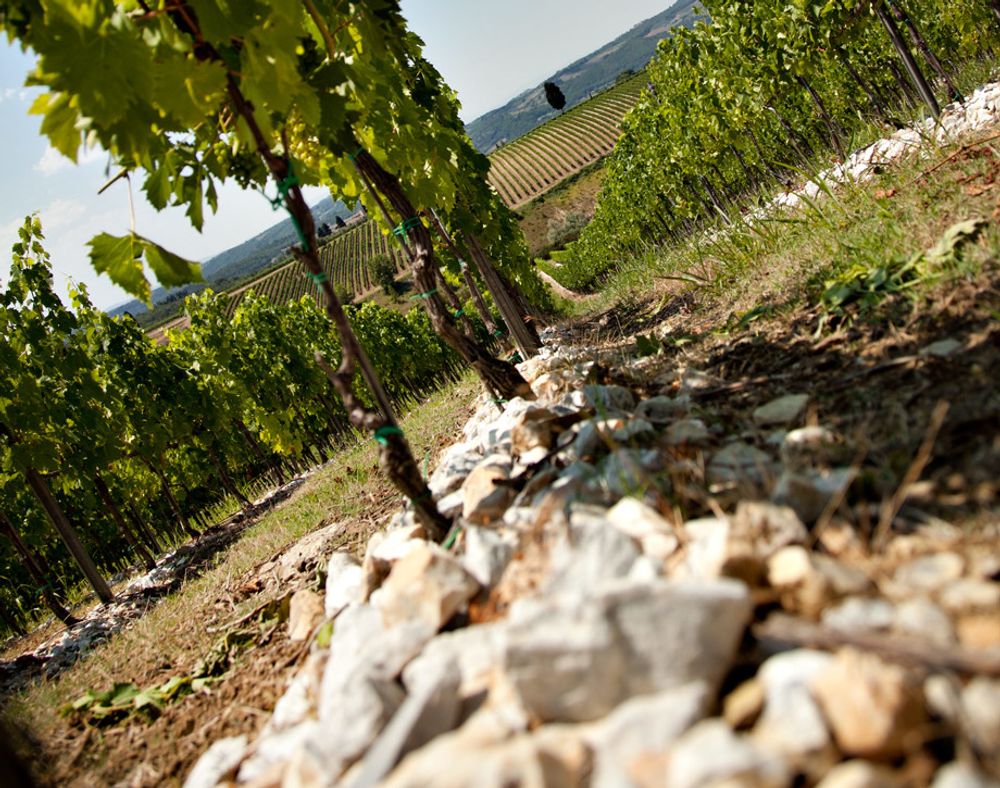
Crushed white stones around the vines acting “like a mirror”
Another innovation carried out at the beginning of the 21st Century was to surround each vine above (15-20 cm) and below ground (30cm) with crushed white stones, the Galestro and Alberese of the region, which reflect sunlight up into the lower parts of the vines, ensuring total ripeness of the fruit whilst keeping the canopy intact.
“We use the whites stones like a mirror,” Visani says, “we put stones, crushed around the vines which allows us to keep more leaves on the plant so the grapes are protected by leaves – but we can still get ripeness.”
“It’s like natural air conditioning,” Antinori adds, explaining that this innovation does away with the need for cover crops which retains moisture/ humidity that Sangiovese vines can suffer from.
This technique is used for the grapes that go into the making of Tignanello and Solaia with the first vintages to have seen the benefit being 2007.
Since 2007 the winemaking team also now waits several months after malolactic fermentation has finished before blending the various components of Solaia, the 2006 we taste being the last vintage that was blended immediately after.
The team also no longer uses new oak for malolactic as the tannins are “more approachable, less compact, less powerful but still there” with 2ndand 3rd use oak. Where the estate used to pre-order barrels from two coopers, it now also waits to order the majority of used barrels after the vintage has finished so that it can determine which type of wood, porosity and level of toast will best suit the new wine.
These many viticultural and winemaking innovations are part of the Antinori DNA and a quest to look for certain things in their premium wines: red fruit rather than black, minerality and drinkability.
“We don’t want to have wines that are too fat, too powerful, we want to produce wines that are tasty without being heavy,” Visani says.
“We are obsessed with tannins,” adds Antinori, “they have to be there, vibrant, but not too big, strong or powerful. The agricultural processes, and also work in the cellar is to manage the right extraction and get the finest tannins.”
And for that this is where 630 years of history and that patience kicks in.
In terms of the history of the blend the first two vintages – 1978/9 were 80/20 Cab Sauv/ Franc and in 2002 the wine was also made without Sangiovese. Years when the wine was not made were 1980, 1981, 1982, 1983, 1984 and 1992.
Antinori makes the point that, even without Sangiovese, Solaia is very “Toscana” – alluding to the minerality of the soil on the estate that is different in composition and produces a very different wine from Bordeaux and even Bolgheri.
Also interesting is that the Solaia bottle label was originally designed by literally using Marchese Antinori’s business card with the Solaia lettering superimposed.
So how was the Solaia 2019 tasting compared to the library wines?
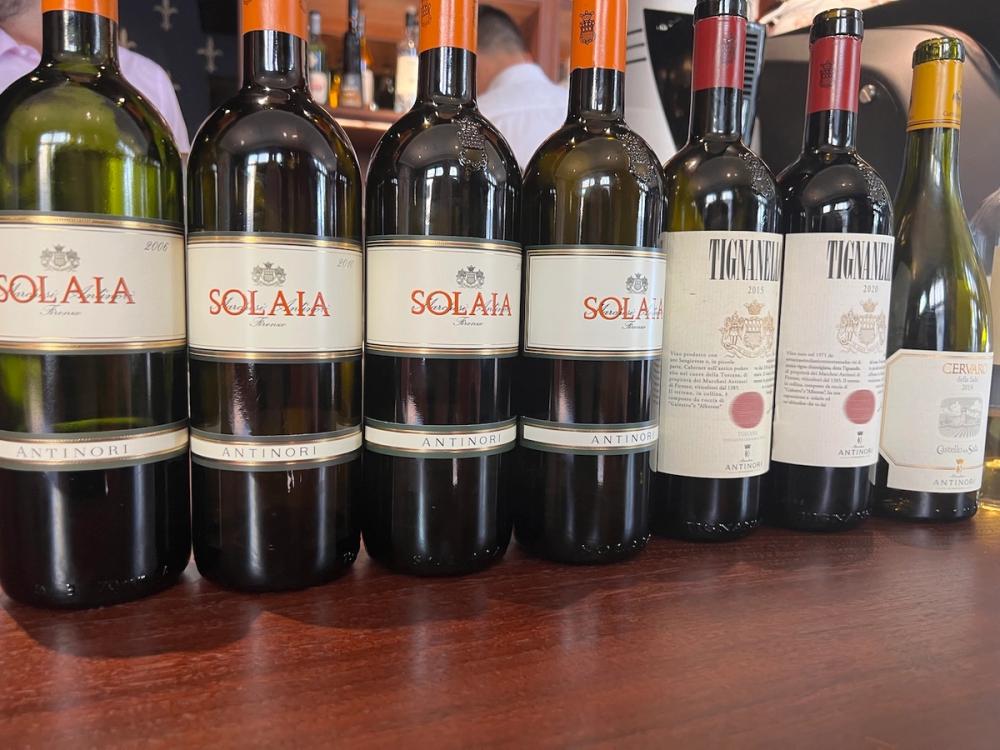
The wines tasted in full
Solaia 2006
2006 was a good year in Tuscany but pretty cold and rainy at the start and during spring – the vines were late flowering – there was good weather at the end of June, July was very hot, in August there was cooler weather with rain every 10 days. September and October were perfect condition wise. Harvest was pretty late compared to current harvests. It was a compact, two week harvest that began at the beginning of October and finished two weeks later. The blending was done just after malolactic finished, it was the last year they did Malo in new oak – since then malo is done in 2-3 year old oak (for 16-18 months).
Tasting wise? Deep ox blood red, bit of bricking on the edges. Pure, concentrated, complex, vanilla, heady; a lovely poise in the mouth, intense but with fine, ripe, compact tannins; as it opened out in the glass (the bottle didn’t seem to have been decanted) the wine showed greater complexity, and the meaty, more savoury Sangiovese note came to the fore. Love this style.
Solaia 2010
One of best vintages in Tuscany, late growing season at the beginning – very cool for this time of year – lot of snowfall; the flowering was late, good temperatures until and including June, but July and August were cool, September was perfect; this vintage had one of the longest harvests at 23 days. Cabernet Franc was picked on 21st September, Sangiovese at the beginning of October, finishing the Cabernet Sauvignon in October.
Best vintage of Solaia on the day – this wine was more precise, cleaner, although two hours after pouring it changed enormously, picking up more of the meaty aged Sangiovese character. Tasting-wise it was fresh, with clean black almost precociously young fruit, intense, slight smoky on the nose, more intense than the ’06. Mouth-filling, fresh, micro-fine tannins, incredible purity, almost a creaminess in the mouth. Feel the acidity more with terrific register on the palate. Stunning.
Solaia 2016
A very mild growing season, mild for 6 months of the year, with much cooler temperatures in the summer, good rainfall with high diurnal temperature range in September and October, also a very long harvest which started with the Cabernet Franc on 28th September and finished three weeks later. Cooler, rainy, a bit more like the 1990s before global warming started to take effect. Because of the rain (which Sangiovese does not like) the Sangiovese was dialled down and the Cabernet Franc increased into the blend to add greater freshness.
To look at, the wine is deep purple, instantly noticeable that there is more Cabernet Franc in the blend with a leafy, minty note, the fruit more mulberry than cassis. In the mouth the wine is clean, fresh, with very smooth tannins – satin-like – there is great intensity here, also lovely elegance and finesse, that old proverbial ‘velvet glove’ structure – there isn’t the length or finish of the ’06 and it tastes very young compared to the other vintages. Clearly a work in progress and clearly an excellent wine in the making
Solaia 2019
The latest wine shines brightly and is very sleek and precise. The 2019 really is a culmination of the points made throughout the masterclass about making the tannins approachable in youth, silky yet defined. And the use of more Cabernet France in the blend which here is 10% against 15% of Sangiovese and 75% Cabernet Sauvignon. Deep purple/red; the fresh aromatics show dark red wild cherries, raspberries, dried herbs and tobacco; the palate is medium bodied, fresh, quite closed, but with svelte, velvet tannins, layers, depth and lots of promise. A masterpiece in the making.
That’s not all folks!
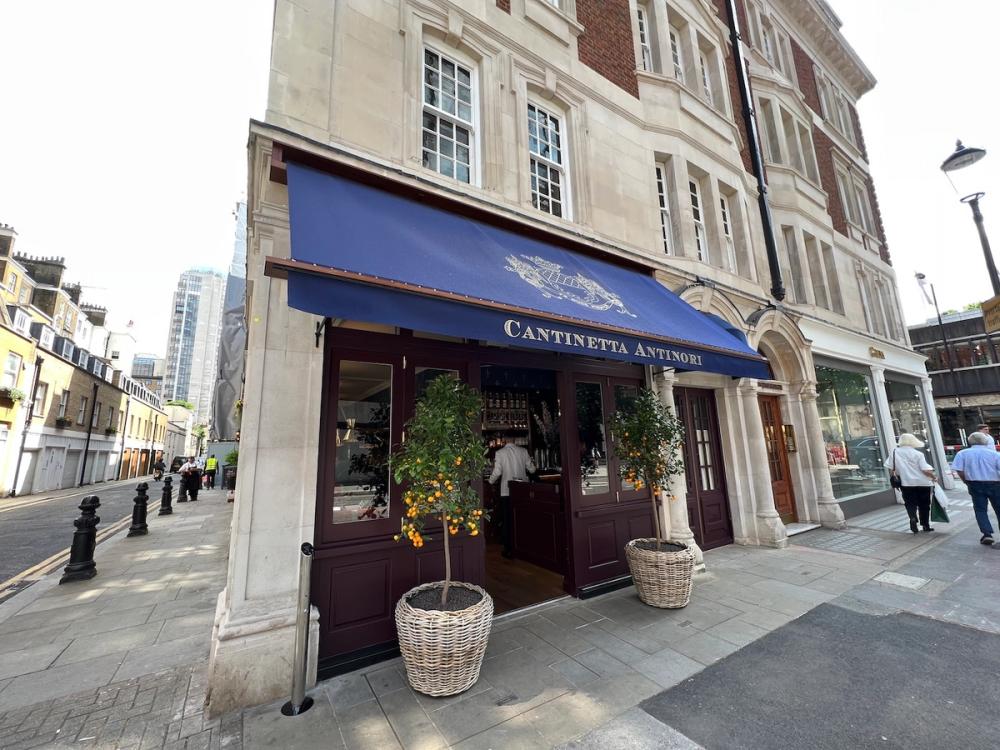
The newly-opened Cantinetta Antinori, London
As with all Antinori functions there were many more wines – two vintages of Tignanello (2015 and 2020) served with a penne and amatricinana beef sauce, the Chardonnay-dominant Cervaro della Sala 2019 served with starters and a Muffatto della Sala 2019 that accompanied a rather pleasing almond chocolate cake with pistachio ice cream.
Antinori started opening Cantinettas in the 1950s and the London opening joins establishments in Vienna and Monte Carlo, although the current financial climate is necessitating a “long, slow launch” – even in Knightsbridge.
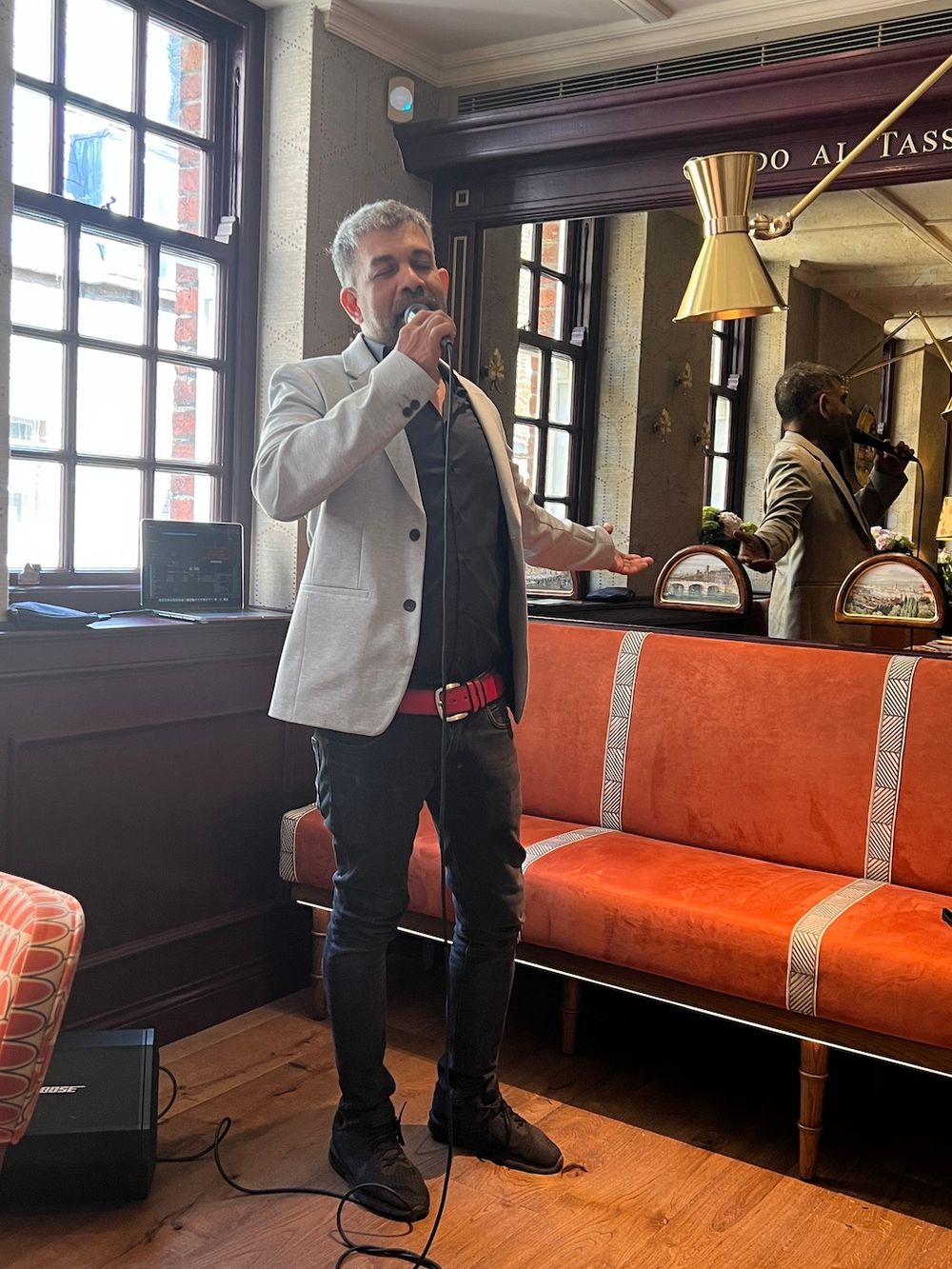
“Volare! oh! oh!” etc
There was also some quirkiness too as is customary with ‘family’ events. Antinori announced halfway through lunch she had a plane to catch leaving the entertainment (a family friend) to wonder when to belt out classic Italian hits like ‘That’s Amore’ and ‘Volare’ – this he did but sadly after most of the guests had left. Nice touch but it would have been novel to have a serious intellectual masterclass on one of the world’s finest wines actually accompanied by a would-be Domenico Modungo. Grazie mille.









































